2017 Peugeot 3008 Hybrid 4 light
[x] Cancel search: lightPage 154 of 566
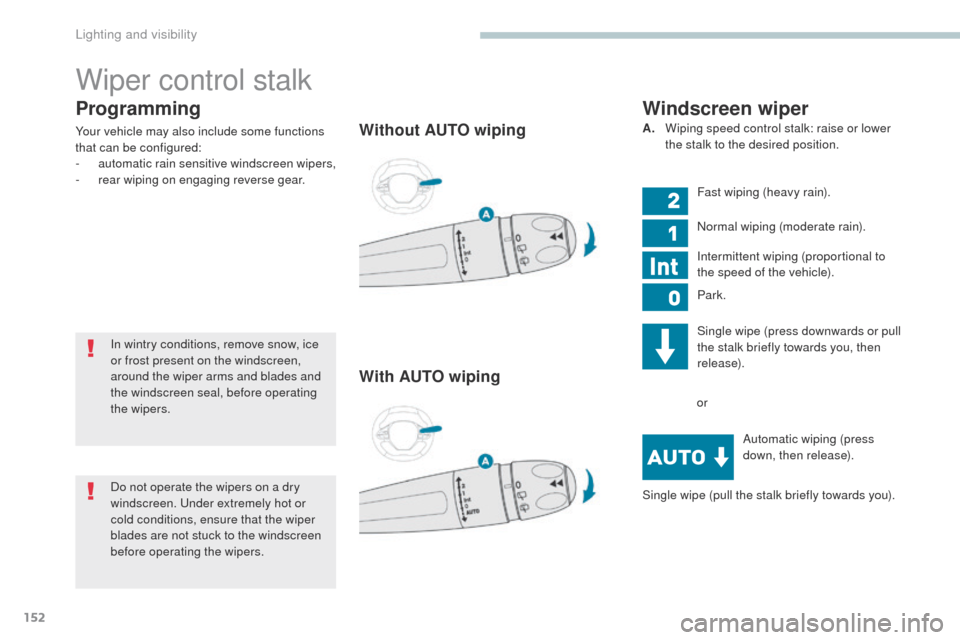
152
3008-2_en_Chap04_eclairage-et-visibilite_ed01-2016
Programming
Your vehicle may also include some functions
that can be configured:
-
a
utomatic rain sensitive windscreen wipers,
-
r
ear wiping on engaging reverse gear.
In wintry conditions, remove snow, ice
or frost present on the windscreen,
around the wiper arms and blades and
the windscreen seal, before operating
the wipers.Without AUTO wiping
With AUTO wiping
Windscreen wiper
A. Wiping speed control stalk: raise or lower the stalk to the desired position.
Fast wiping (heavy rain).
Normal wiping (moderate rain).
Intermittent wiping (proportional to
the speed of the vehicle).
Park.
Single wipe (press downwards or pull
the stalk briefly towards you, then
release).
Automatic wiping (press
down, then release).
or
Wiper control stalk
Single wipe (pull the stalk briefly towards you).
Do not operate the wipers on a dry
windscreen. Under extremely hot or
cold conditions, ensure that the wiper
blades are not stuck to the windscreen
before operating the wipers.
Lighting and visibility
Page 155 of 566

153
3008-2_en_Chap04_eclairage-et-visibilite_ed01-2016
B. Rear wiper selection ring: turn the ring
to place the desired symbol against the
marking.
Rear wiper
Park.
Intermittent wipe.
Wash-wipe. F
P
ull the wiper control stalk towards you.
The screenwash and then the wiper operate for
a fixed time.
The screenwash includes a wiper blade
system with integral washer jets called
"Magic Wash".
The screenwash fluid is sprayed from
all along the length of the wiper blade;
this improves visibility and reduces the
consumption of screenwash fluid.
Windscreen wash
Reverse gear
When reverse gear is engaged, the rear wiper
will come into operation automatically if the
windscreen wipers are operating.
The function is activated or deactivated via the
vehicle settings menu in the screen.
In the event of snow or hard frost,
deactivate the automatic rear wiper via
the vehicle settings menu in the screen.
Turn the ring fully; the rear screen wash, then
the rear wiper automatically operate for a set
duration. This function is activated by default.
4
Lighting and visibility
Page 156 of 566
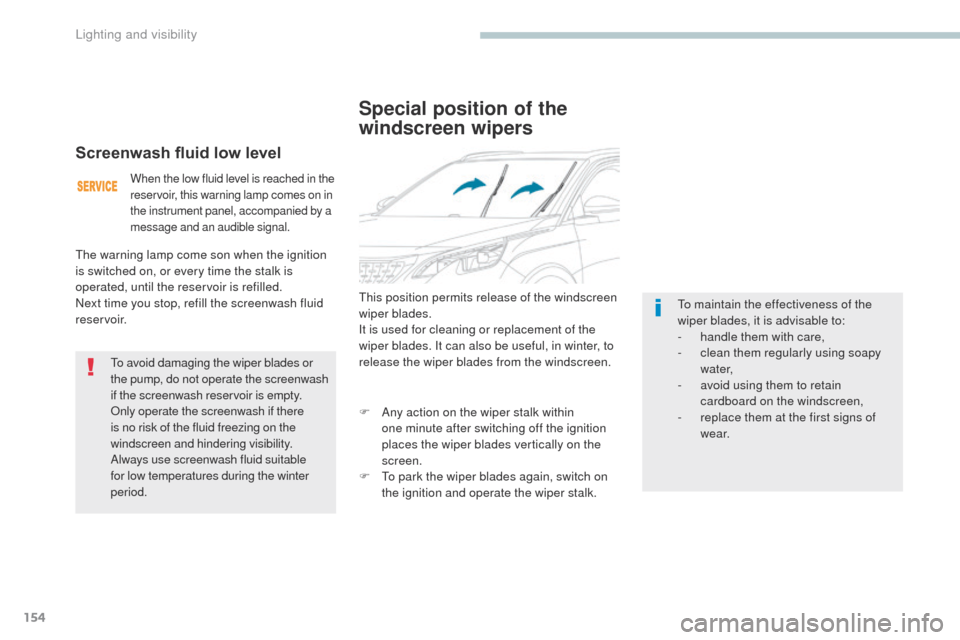
154
3008-2_en_Chap04_eclairage-et-visibilite_ed01-2016
Special position of the
windscreen wipers
This position permits release of the windscreen
wiper blades.
It is used for cleaning or replacement of the
wiper blades. It can also be useful, in winter, to
release the wiper blades from the windscreen.
F
A
ny action on the wiper stalk within
one
minute after switching off the ignition
places the wiper blades vertically on the
screen.
F
T
o park the wiper blades again, switch on
the ignition and operate the wiper stalk. To maintain the effectiveness of the
wiper blades, it is advisable to:
-
h
andle them with care,
-
c
lean them regularly using soapy
water,
-
a
void using them to retain
cardboard on the windscreen,
-
r
eplace them at the first signs of
w e a r.
Screenwash fluid low level
When the low fluid level is reached in the
reservoir, this warning lamp comes on in
the instrument panel, accompanied by a
message and an audible signal.
The warning lamp come son when the ignition
is switched on, or every time the stalk is
operated, until the reservoir is refilled.
Next time you stop, refill the screenwash fluid
reservoir.
To avoid damaging the wiper blades or
the pump, do not operate the screenwash
if the screenwash reservoir is empty.
Only operate the screenwash if there
is no risk of the fluid freezing on the
windscreen and hindering visibility.
Always use screenwash fluid suitable
for low temperatures during the winter
period.
Lighting and visibility
Page 157 of 566

155
3008-2_en_Chap04_eclairage-et-visibilite_ed01-2016
Automatic rain sensitive windscreen wipers
Switching on
F Briefly push the control stalk down.
A wiping cycle confirms that the instruction has
been accepted.
Switching off
F Briefly push the control stalk down again, or place the control stalk in another
position ( Int, 1 or 2 ).
The automatic rain sensitive windscreen
wipers must be reactivated by pushing
the control stalk downwards, if the
ignition has been off for more than
one
minute.
This warning lamp comes on in the
instrument panel, accompanied by a
message.
This warning lamp goes off in the
instrument panel, accompanied by a
message.
The windscreen wipers operate automatically, adapting their speed to the intensity of the rainfall without any action on the part of the driver.
Detection of rainfall is by means of a sensor at the top centre of the windscreen, behind the rear view mirror.
Operating fault
If a fault occurs with the automatic rain
sensitive wipers, the wipers will operate in
intermittent mode.
Have them checked by PEUGEOT dealer or a
qualified workshop.
Do not cover the rain sensor, linked with
the sunshine sensor and located in the top
centre of the windscreen.
Switch off the automatic rain sensitive
wipers when using an automatic car wash.
In winter, it is advisable to wait until the
windscreen is completely clear of ice
before activating the automatic rain
sensitive wipers.
4
Lighting and visibility
Page 163 of 566
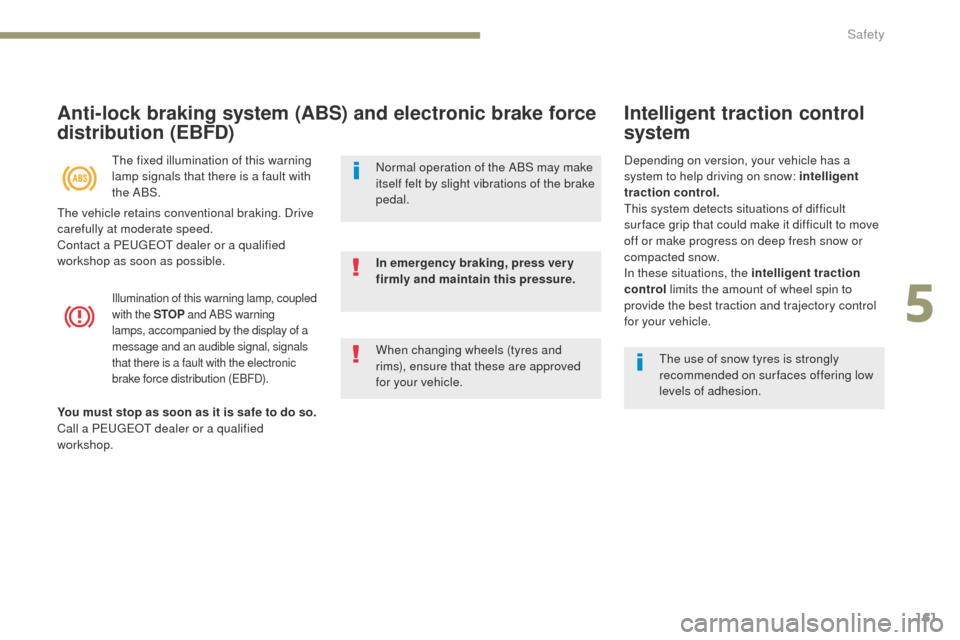
161
3008-2_en_Chap05_securite_ed01-2016
Anti-lock braking system (ABS) and electronic brake force
distribution (EBFD)
The fixed illumination of this warning
lamp signals that there is a fault with
the ABS.
Illumination of this warning lamp, coupled
with the STOP and ABS warning
lamps, accompanied by the display of a
message and an audible signal, signals
that there is a fault with the electronic
brake force distribution (EBFD).
You must stop as soon as it is safe to do so.
Call a PEUGEOT dealer or a qualified
workshop. When changing wheels (tyres and
rims), ensure that these are approved
for your vehicle. In emergency braking, press ver y
firmly and maintain this pressure. Normal operation of the ABS may make
itself felt by slight vibrations of the brake
pedal.
Intelligent traction control
system
Depending on version, your vehicle has a
system to help driving on snow: intelligent
traction control.
This system detects situations of difficult
sur face grip that could make it difficult to move
off or make progress on deep fresh snow or
compacted snow.
In these situations, the intelligent traction
control
limits the amount of wheel spin to
provide the best traction and trajectory control
for your vehicle.
The use of snow tyres is strongly
recommended on sur faces offering low
levels of adhesion.
The vehicle retains conventional braking. Drive
carefully at moderate speed.
Contact a PEUGEOT dealer or a qualified
workshop as soon as possible.
5
Safety
Page 165 of 566

163
3008-2_en_Chap05_securite_ed01-2016
Trailer stability assist
Operation
The system is activated automatically when the
ignition is switched on.
The electronic stability programme (ESC) must
not have any faults.
Between 36 and 100 mph (60 and 160 km/h), if
the system detect oscillations (snaking) in the
movement of the trailer, it acts on the brakes to
stabilise the trailer and, if necessary, reduces
engine power to slow down the vehicle.
For information on the weights and towed
loads, refer to the "Technical data" section or
the registration certificate for your vehicle.
For advice on driving safely when To w i n g
a trailer , refer to the corresponding section.
When towing, this system reduces the risk of the vehicle or trailer snaking.
It is available on vehicles with factory-fitted trailer wiring (preparation for towbar option or the towbar with quickly-detachable towball pack).
The correction is signalled by the
flashing of this indicator lamp in the
instrument panel and illumination of
the brake lamps.
Operating fault
Should a fault occur with the system,
this warning lamp comes on in the
instrument panel, accompanied by
the display of a message and an
audible signal.
If you continue to tow a trailer, reduce your
speed and drive carefully!
Contact a PEUGEOT dealer or a qualified
workshop
to have the system checked. The trailer stability assist system offers
increased safety in normal driving,
provided that the recommendations on
towing a trailer are observed. It should
not encourage the driver to take risks,
such as towing a trailer in adverse
operating conditions (overloading,
failure to observe the trailer nose
weight, worn or under-inflated tyres,
faulty braking system, ….)
or drive at
too high a speed.
In certain certain cases, oscillation of
the trailer may not be detected by the
ESC system, particularly with a light
t r a i l e r.
When driving on slippery or poor
sur faces, the system may not be able to
prevent sudden snaking of the trailer.
5
Safety
Page 173 of 566
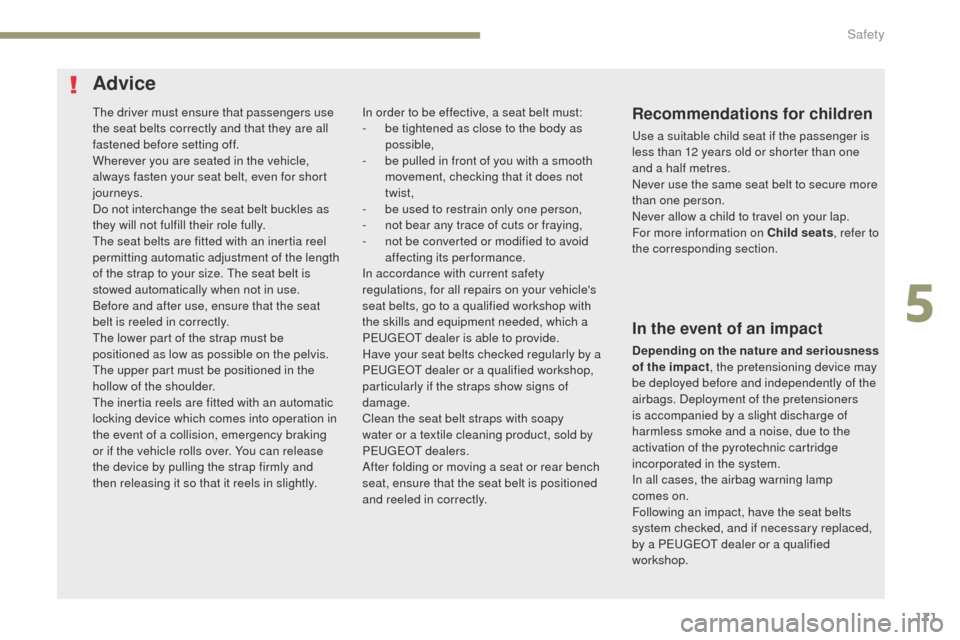
171
3008-2_en_Chap05_securite_ed01-2016
The driver must ensure that passengers use
the seat belts correctly and that they are all
fastened before setting off.
Wherever you are seated in the vehicle,
always fasten your seat belt, even for short
journeys.
Do not interchange the seat belt buckles as
they will not fulfill their role fully.
The seat belts are fitted with an inertia reel
permitting automatic adjustment of the length
of the strap to your size. The seat belt is
stowed automatically when not in use.
Before and after use, ensure that the seat
belt is reeled in correctly.
The lower part of the strap must be
positioned as low as possible on the pelvis.
The upper part must be positioned in the
hollow of the shoulder.
The inertia reels are fitted with an automatic
locking device which comes into operation in
the event of a collision, emergency braking
or if the vehicle rolls over. You can release
the device by pulling the strap firmly and
then releasing it so that it reels in slightly.Recommendations for children
Use a suitable child seat if the passenger is
less than 12 years old or shorter than one
and a half metres.
Never use the same seat belt to secure more
than one person.
Never allow a child to travel on your lap.
For more information on Child seats, refer to
the corresponding section.
In the event of an impact
Depending on the nature and seriousness
of the impact , the pretensioning device may
be deployed before and independently of the
airbags. Deployment of the pretensioners
is accompanied by a slight discharge of
harmless smoke and a noise, due to the
activation of the pyrotechnic cartridge
incorporated in the system.
In all cases, the airbag warning lamp
comes
on.
Following an impact, have the seat belts
system checked, and if necessary replaced,
by a PEUGEOT dealer or a qualified
workshop.
Advice
In order to be effective, a seat belt must:
- b e tightened as close to the body as
possible,
-
b
e pulled in front of you with a smooth
movement, checking that it does not
twist,
-
b
e used to restrain only one person,
-
n
ot bear any trace of cuts or fraying,
-
n
ot be converted or modified to avoid
affecting its performance.
In accordance with current safety
regulations, for all repairs on your vehicle's
seat belts, go to a qualified workshop with
the skills and equipment needed, which a
PEUGEOT dealer is able to provide.
Have your seat belts checked regularly by a
PEUGEOT dealer or a qualified workshop,
particularly if the straps show signs of
damage.
Clean the seat belt straps with soapy
water or a textile cleaning product, sold by
PEUGEOT dealers.
After folding or moving a seat or rear bench
seat, ensure that the seat belt is positioned
and reeled in correctly.
5
Safety
Page 174 of 566
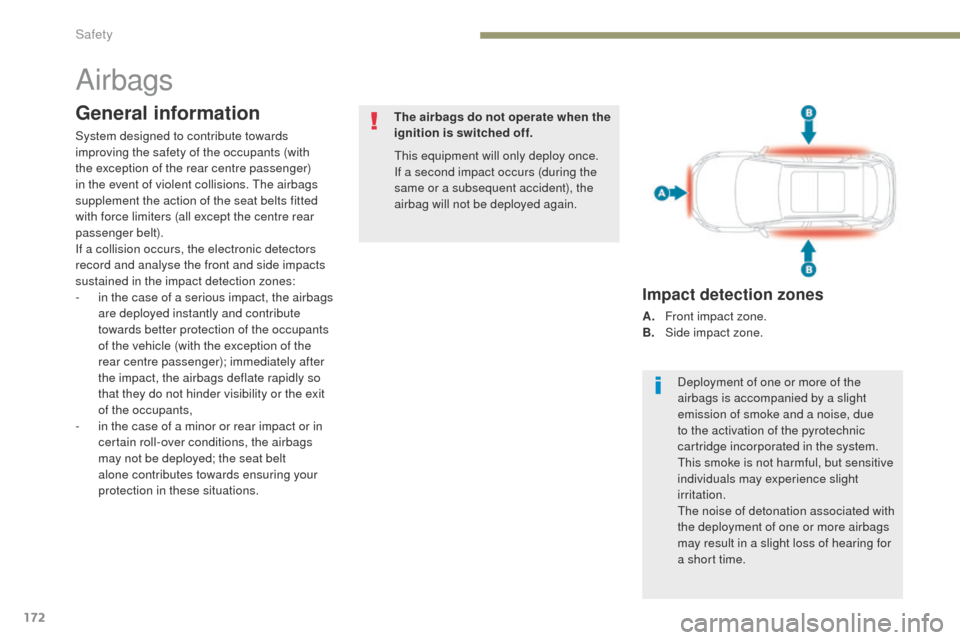
172
3008-2_en_Chap05_securite_ed01-2016
Airbags
General information
System designed to contribute towards
improving the safety of the occupants (with
the exception of the rear centre passenger)
in the event of violent collisions. The airbags
supplement the action of the seat belts fitted
with force limiters (all except the centre rear
passenger belt).
If a collision occurs, the electronic detectors
record and analyse the front and side impacts
sustained in the impact detection zones:
-
i
n the case of a serious impact, the airbags
are deployed instantly and contribute
towards better protection of the occupants
of the vehicle (with the exception of the
rear centre passenger); immediately after
the impact, the airbags deflate rapidly so
that they do not hinder visibility or the exit
of the occupants,
-
i
n the case of a minor or rear impact or in
certain roll-over conditions, the airbags
may not be deployed; the seat belt
alone contributes towards ensuring your
protection in these situations.
Impact detection zones
A. Front impact zone.
B. S ide impact zone.
The airbags do not operate when the
ignition is switched off.
This equipment will only deploy once.
If a second impact occurs (during the
same or a subsequent accident), the
airbag will not be deployed again.
Deployment of one or more of the
airbags is accompanied by a slight
emission of smoke and a noise, due
to the activation of the pyrotechnic
cartridge incorporated in the system.
This smoke is not harmful, but sensitive
individuals may experience slight
irritation.
The noise of detonation associated with
the deployment of one or more airbags
may result in a slight loss of hearing for
a short time.
Safety